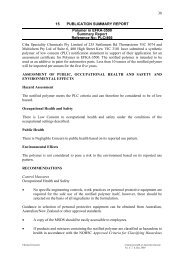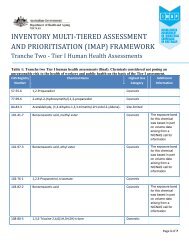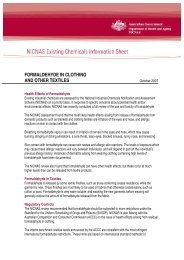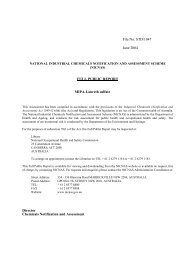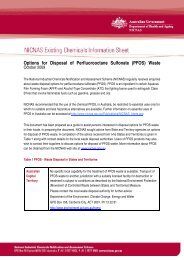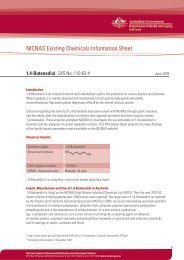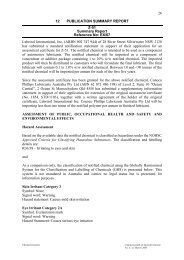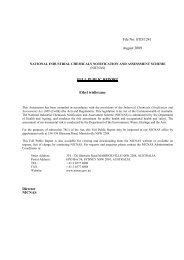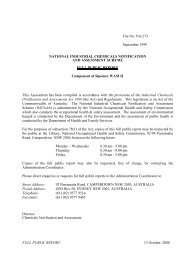t-amyl peroxyoctoate (Luperox 575) - NICNAS
t-amyl peroxyoctoate (Luperox 575) - NICNAS
t-amyl peroxyoctoate (Luperox 575) - NICNAS
Create successful ePaper yourself
Turn your PDF publications into a flip-book with our unique Google optimized e-Paper software.
File No: NA/835<br />
January 2001<br />
NATIONAL INDUSTRIAL CHEMICALS NOTIFICATION<br />
AND ASSESSMENT SCHEME<br />
FULL PUBLIC REPORT<br />
t-<strong>amyl</strong> <strong>peroxyoctoate</strong> (<strong>Luperox</strong> <strong>575</strong>)<br />
This Assessment has been compiled in accordance with the provisions of the Industrial Chemicals<br />
(Notification and Assessment) Act 1989 (the Act) and Regulations. This legislation is an Act of the<br />
Commonwealth of Australia. The National Industrial Chemicals Notification and Assessment<br />
Scheme (<strong>NICNAS</strong>) is administered by the National Occupational Health and Safety Commission<br />
which also conducts the occupational health & safety assessment. The assessment of environmental<br />
hazard is conducted by the Department of the Environment and the assessment of public health is<br />
conducted by the Department of Health and Aged Care.<br />
For the purposes of subsection 78(1) of the Act, copies of this full public report may be inspected by<br />
the public at the Library, National Occupational Health and Safety Commission, 92-94 Parramatta<br />
Road, Camperdown NSW 2050, between the following hours:<br />
Monday - Wednesday 8.30 am - 5.00 pm<br />
Thursday 8.30 am - 8.00 pm<br />
Friday 8.30 am - 5.00 pm<br />
Copies of this full public report may also be requested, free of charge, by contacting the<br />
Administration Coordinator on the fax number below.<br />
For enquiries please contact the Administration Coordinator at:<br />
Street Address: 92 -94 Parramatta Rd CAMPERDOWN NSW 2050, AUSTRALIA<br />
Postal Address: GPO Box 58, SYDNEY NSW 2001, AUSTRALIA<br />
Telephone: (61) (02) 9577 9514 FAX (61) (02) 9577 9465<br />
Director<br />
Chemicals Notification and Assessment
TABLE OF CONTENTS<br />
FULL PUBLIC REPORT.......................................................................................................................3<br />
1. APPLICANT..............................................................................................................................3<br />
2. IDENTITY OF THE CHEMICAL.............................................................................................3<br />
3. PHYSICAL AND CHEMICAL PROPERTIES.........................................................................4<br />
3.1 Comments on Physico-Chemical Properties ......................................................................5<br />
4. PURITY OF THE CHEMICAL.................................................................................................5<br />
5. USE, VOLUME AND FORMULATION..................................................................................5<br />
6. OCCUPATIONAL EXPOSURE ...............................................................................................6<br />
7. PUBLIC EXPOSURE ................................................................................................................6<br />
8. ENVIRONMENTAL EXPOSURE............................................................................................7<br />
8.1 Release ...............................................................................................................................7<br />
8.2 Fate.....................................................................................................................................7<br />
9. EVALUATION OF TOXICOLOGICAL DATA.......................................................................8<br />
9.1 Acute Toxicity....................................................................................................................8<br />
9.2 Repeated Dose Toxicity (TBEC) (MB Research Laboratories, 1999a) ...........................12<br />
9.3 Genotoxicity.....................................................................................................................13<br />
9.4 Induction of Sustained Skin Hyperplasia and DNA Damage (Slaga, 1997) ....................15<br />
9.5 Overall Assessment of Toxicological Data......................................................................16<br />
10. ASSESSMENT OF ENVIRONMENTAL EFFECTS .........................................................16<br />
11. ASSESSMENT OF ENVIRONMENTAL HAZARD .........................................................18<br />
12. ASSESSMENT OF PUBLIC AND OCCUPATIONAL HEALTH AND SAFETY<br />
EFFECTS .........................................................................................................................................19<br />
13. RECOMMENDATIONS .....................................................................................................20<br />
14. MATERIAL SAFETY DATA SHEET................................................................................21<br />
15. REQUIREMENTS FOR SECONDARY NOTIFICATION................................................21<br />
16. REFERENCES.....................................................................................................................21
1. APPLICANT<br />
FULL PUBLIC REPORT<br />
NA/835<br />
FULL PUBLIC REPORT<br />
t-<strong>amyl</strong> <strong>peroxyoctoate</strong> (<strong>Luperox</strong> <strong>575</strong>)<br />
NA/835<br />
Atofina (Australia) Pty Ltd (ACN No. 000 330 772) of 270 – 280 Hammond Rd<br />
DANDENONG SOUTH VIC 3175 has submitted a standard notification statement in support<br />
of their application for an assessment certificate for <strong>Luperox</strong> <strong>575</strong>.<br />
2. IDENTITY OF THE CHEMICAL<br />
The chemical impurities, exact use and details of exact import volume have been exempted<br />
from publication in the Full Public Report and the Summary Report.<br />
Chemical Name: hexaneperoxoic acid, 2-ethyl-, 1,1-dimethylpropyl ester<br />
Chemical Abstracts Service<br />
(CAS) Registry No.:<br />
686-31-7<br />
Other Names: t-<strong>amyl</strong> <strong>peroxyoctoate</strong><br />
t-<strong>amyl</strong> peroxy(2-ethylhexanoate)<br />
Marketing Name: <strong>Luperox</strong> <strong>575</strong><br />
Lupersol <strong>575</strong><br />
Molecular Formula: C13H26O3<br />
Structural Formula:<br />
CH3<br />
|<br />
CH2 CH3<br />
| |<br />
CH3(CH2)3 ⎯ CH ⎯ C ⎯ O ⎯ O ⎯ C ⎯ CH2 ⎯ CH3<br />
|| |<br />
O CH3<br />
Molecular Weight: 230.35<br />
Method of Detection and Infrared (IR) spectroscopy.<br />
22 January 2001<br />
3/24
Determination:<br />
Spectral Data: An IR spectrum was provided.<br />
3. PHYSICAL AND CHEMICAL PROPERTIES<br />
The following data were contained in a report using computer modelling or in a product<br />
Material Safety Data Sheet (MSDS).<br />
Appearance at 20°C & 101.3 kPa: Clear liquid.<br />
Freezing Point: < -80°C<br />
Specific Gravity: 0.9028 at 25°C<br />
Vapour Pressure: 0.88 kPa at 15°C (estimated – see notes below).<br />
Water Solubility: Estimated at 2.4mg/L at 25°C (estimated – see notes<br />
below).<br />
Partition Co-efficient<br />
(n-octanol/water):<br />
Particle Size: Not relevant.<br />
FULL PUBLIC REPORT<br />
NA/835<br />
Calculated log Kow = 4.8 (see notes below).<br />
Hydrolysis as a Function of pH: Calculated T1/2 at pH 7.0 = 8.3 days.<br />
Calculated T1/2 at pH 8.0 = 19.8 hours<br />
Adsorption/Desorption: Calculated logKoc = 3.4.<br />
Dissociation Constant: Not determined – see notes below.<br />
Henry’s Law Constant: H = 83 300 Pa.m 3<br />
/mole, log H = 4.92 (calculated,<br />
see notes below.)<br />
Flash Point: 71°C<br />
Flammability Limits: Not determined.<br />
Autoignition Temperature: > 45°C<br />
Explosive Properties: The self accelerating decomposition temperature is<br />
45°C.<br />
Reactivity/Stability: Unstable. Half-life = 16 hours.<br />
22 January 2001<br />
4/24
3.1 Comments on Physico-Chemical Properties<br />
All the physico-chemical data provided were derived from model calculations using the<br />
ECOSAR program via appropriate Quantitative Structure Activity Relationships (QSARs).<br />
While measured data would have been preferable, it is appreciated that due to the unstable<br />
nature of the compound accurate measurement of these properties would be difficult.<br />
The estimated low water solubility and high values for log Pow and log Koc are in accord with<br />
the high hydrocarbon content of the notified chemical. These data indicate that if the<br />
compound were stable, it would partition into oil and fat, and if released to soil would bind to<br />
and associate with the organic component of soils and sediments.<br />
The Henry’s law constant was calculated from the (estimated) vapour pressure and water<br />
solubility using the relation –<br />
H = Vapour pressure (Pa) X Molecular weight (g/mol)/ Water solubility (g/L).<br />
The large estimated value of H indicates that the compound would volatilise from water if<br />
released in solution.<br />
The compound contains a peroxycarbonate linkage which could be susceptible to hydrolysis.<br />
However, the peroxide group itself is highly reactive, and in an aqueous environment the<br />
chemical would be more likely to decompose to t-<strong>amyl</strong> alcohol and 2-ethyl hexanol with<br />
concomitant evolution of O2 through reactions of the peroxide group rather than undergo<br />
hydrolytic cleavage.<br />
The compound contains no acidic or basic groups, so dissociation constant data are not<br />
relevant.<br />
4. PURITY OF THE CHEMICAL<br />
Degree of Purity: minimum of 95%<br />
Hazardous Impurities: < 4.1%. No impurities at a concentration which would<br />
render the notified chemical hazardous.<br />
Non-hazardous Impurities<br />
(> 1% by weight):<br />
Additives/Adjuvants:<br />
FULL PUBLIC REPORT<br />
NA/835<br />
None.<br />
None.<br />
5. USE, VOLUME AND FORMULATION<br />
The notified chemical will be used as a polymerisation initiator. It will be used at a level of<br />
0.5 – 2% by weight in reactions with monomers and will be imported in 15.6 kg polyethylene<br />
closed head cube carboy containers. Less than 10 tonnes per annum are to be imported for<br />
the first 5 years.<br />
22 January 2001<br />
5/24
6. OCCUPATIONAL EXPOSURE<br />
Transport and Storage<br />
The notified chemical will be imported by the notifier and delivered to a single customer on a<br />
just in time basis in the desired quantity for the batch size to be manufactured. The chemical<br />
is classified as a Dangerous Good and is assigned UN No. 3115, Organic Peroxide, Type D,<br />
Liquid, Class 5.2, and is required to be stored below 10°C and transported in accordance with<br />
the ADG code. Exposure of workers during transport and storage is only likely to occur in<br />
the event of accidental spillage.<br />
Laboratory Testing<br />
Quantities of 20 – 200 grams will be weighed out in glassware and added to batches of 4 –<br />
10 kg for testing in a fume hood. Laboratory staff (3) working 8 hours per day, 10 days per<br />
year wear a laboratory coat, safety shoes, safety glasses and rubber gloves when conducting<br />
tests.<br />
Resin Manufacture<br />
Nine workers working 8 hours per day, 20 days per year manually add the notified chemical<br />
in a full pack size with solvent to a sealed weigh vessel under local exhaust ventilation. The<br />
solvent is used to rinse the container so that little residue remains. The weigh vessel is used<br />
to charge the main reactor which is filled under local exhaust ventilation. The solvent and<br />
notified chemical feeds to the main reactor are conducted over several hours. The notified<br />
chemical is of low volatility and this, coupled with the use of fume extraction should preclude<br />
inhalation exposure. Nevertheless, the notifier states that respiratory protection is normally<br />
worn during resin manufacture. Dermal exposure of workers is possible during transfer<br />
operations. Workers wear overalls, safety boots, goggles and gloves to prevent exposure<br />
while handling the notified chemical. Once the reaction is complete, the notified chemical<br />
becomes incorporated into the polymer and the polymer solution is discharged to bulk storage<br />
tanks or to 200 L drums.<br />
Workers handling the notified chemical are experienced at handling other organic peroxides.<br />
After polymerisation, the notified chemical is chemically bonded to long polymer chains and<br />
becomes an integral part of the polymer. The polymers will ultimately be used in the<br />
manufacture of metal coatings.<br />
7. PUBLIC EXPOSURE<br />
The notified chemical, resin solution and final paint products will be used in industry only.<br />
The public will come into contact with the notified chemical only after the paint products<br />
have been applied to substrates where a coating film is formed in which the notified chemical<br />
is incorporated. The notified chemical will not be available for absorption when incorporated<br />
into the films and public exposure should be negligible.<br />
FULL PUBLIC REPORT<br />
NA/835<br />
22 January 2001<br />
6/24
8. ENVIRONMENTAL EXPOSURE<br />
8.1 Release<br />
Minimal release during charging of the slurry tank is expected, and any spills and splashes of<br />
the compound would most likely be diluted with water and combined with the overall liquid<br />
waste stream within the plant.<br />
It was indicated in the submission that the polymerisation reactor is a refluxing vessel –<br />
presumably allowing for complete vapour return to the reactor. This and other engineering<br />
controls would minimise releases of gases and vapours to the atmosphere during the<br />
polymerisation process.<br />
Apart from accidents, very little release of the chemical is expected during addition to the<br />
reaction vessel and during the polymerisation process. Since the chemical decomposes to free<br />
radicals during the process, no release of the chemical with the final product is expected.<br />
Further, the free radicals are themselves incorporated into the polymer, so little release of<br />
decomposition products is expected.<br />
The notifier indicated that the reaction batch sizes are arranged to require multiples of a full<br />
container load of notified chemical (15.6 kg), so that little unused compound remains in the<br />
emptied carboys. Further, small quantities of residual material are washed out of the<br />
containers with solvent and added to the reactor. Consequently very little of the notified<br />
chemical is likely to be released with disposal of the emptied carboys into landfill.<br />
A small amount of the notified chemical from development laboratories may be released with<br />
other plant industrial waste effluent to the municipal sewer, possibly after pre-treatment.<br />
8.2 Fate<br />
All of the notified chemical is consumed during resin manufacture and becomes incorporated<br />
into the polymer chains. Except in the case of accident there is little likelihood of release of<br />
the chemical, but if this were to occur the chemical is expected to rapidly decompose through<br />
rupture of the peroxide bonds. The decomposition products would most likely be carbon<br />
dioxide and the two alcohol species indicated above. Rapid decomposition of organic<br />
peroxides is effectively catalysed through ferrous ions, which are invariably present in soils<br />
and natural waters.<br />
The notifier provided a draft summary test report on the aerobic biodegradation in a closed<br />
bottle test (OECD TG 301 D) for a close structural analogue of the compound ie. tbutylperoxy<br />
2-ethylhexyl carbonate (TBEC), which was previously assessed as NA/710. The<br />
test material appears to be ultimately biodegradable. This biodegradation test is probably<br />
more representative of that for an equimolar mixture of t-butyl alcohol and 2-ethyl hexanol<br />
rather than of the initial test compound itself, since this is expected to degrade quickly to<br />
these two alcohols.<br />
FULL PUBLIC REPORT<br />
NA/835<br />
22 January 2001<br />
7/24
The high estimated value for log Koc indicates that chemical released to the soil as a result of<br />
spill or accident would become bound to the organic component of the soil. The notified<br />
chemical is unlikely to be mobile in the soil compartment, and is expected to decompose<br />
rapidly through reaction of the peroxide group.<br />
Small neutral compounds with high log Pow values and low water solubility have a potential<br />
for bioaccumulation (Connell, 1989), so the notified chemical could potentially<br />
bioaccumulate if it persisted in the environment. However, the inherent instability of the<br />
chemical indicates a very short lifetime in the environment, and so bioaccumulation is<br />
considered unlikely.<br />
The notified chemical is volatile and has a high Henry’s law constant. Therefore, it is<br />
possible on release to water that some of the chemical would enter the atmospheric<br />
compartment. In this situation it would decompose through photo-degradation reactions with<br />
atmospheric hydroxy radicals. The notifier indicated that the overall rate constant for reaction<br />
of the notified chemical with these radicals is 8 x 10 -12 cm 3 /mol/sec. Taking the average<br />
concentration of the OH radicals as 1.5 x 10 6 radicals/cm 3 , the atmospheric half life is around<br />
16 hours.<br />
9. EVALUATION OF TOXICOLOGICAL DATA<br />
Skin sensitisation, repeated dose toxicity and chromosomal damage studies were not available<br />
for the notified chemical. However, these studies have been conducted with the analogue<br />
TBEC notified as NA/710 and extracts from the Full Public Report for this chemical are<br />
reproduced below in the relevant sections.<br />
9.1 Acute Toxicity<br />
Summary of the acute toxicity of t-<strong>amyl</strong> <strong>peroxyoctoate</strong><br />
Test Species Outcome Reference<br />
acute oral toxicity rat LD50 > 5 000 mg/kg (Reagan, Becci &<br />
Parent, 1981a)<br />
acute dermal toxicity rabbit LD50 > 2 000 mg/kg (Reagan, Becci &<br />
Parent, 1981b)<br />
skin irritation rabbit Slight to moderate irritant (Reagan, Becci &<br />
Parent, 1981c)<br />
eye irritation rabbit Not irritant (Reagan, Becci &<br />
Parent, 1981d)<br />
9.1.1 Oral Toxicity (Reagan, Becci & Parent, 1981a)<br />
Species/strain: Rat/Sprague-Dawley<br />
Number/sex of animals: 5/sex<br />
FULL PUBLIC REPORT<br />
NA/835<br />
22 January 2001<br />
8/24
Observation period: 14 days<br />
Method of administration: Oral (gavage) at a dose of 5g/kg body weight.<br />
Test method: OECD TG 401<br />
Mortality: None.<br />
Clinical observations: Ataxia, decreased activity, soft stool, wet yellow belly and<br />
diarrhea on days 1 and 2.<br />
Morphological findings: Not given.<br />
LD50: > 5 000 mg/kg<br />
Result: The notified chemical was of very low acute oral toxicity in<br />
rats.<br />
9.1.2 Dermal Toxicity (Reagan, Becci & Parent, 1981b)<br />
Species/strain: Rabbit/New Zealand White (NZW).<br />
Number/sex of animals: 5/sex<br />
Observation period: 14 days<br />
Method of administration: Under occlusive dressing for 24 hours at a dose of 2g/kg on<br />
abraded and intact skin.<br />
Test method: Similar to OECD TG 402.<br />
Mortality: One animal died on day 7.<br />
Clinical observations: From day 11 scattered observations of diarrhea, soft stool<br />
and loss of appetite.<br />
Morphological findings: None given.<br />
LD50: > 2 000 mg/kg<br />
Result: the notified chemical was of low dermal toxicity in rats<br />
9.1.3 Inhalation Toxicity<br />
Not provided.<br />
FULL PUBLIC REPORT<br />
NA/835<br />
22 January 2001<br />
9/24
9.1.4 Skin Irritation (Reagan, Becci & Parent, 1981c)<br />
Species/strain: Rabbit/NZW<br />
Number/sex of animals: 6/males.<br />
Observation period: 72 hours.<br />
Method of administration: 0.5 mL of the test substance under occlusive dressing for 24<br />
hours on intact and abraded skin.<br />
Test method: Similar to OECD TG 404.<br />
Draize scores for animals with intact skin:<br />
Time after Animal #<br />
treatment<br />
(days)<br />
Erythema<br />
1 2 3 4 5 6<br />
Oedema<br />
FULL PUBLIC REPORT<br />
NA/835<br />
1 2 a 2 2 1 1 1<br />
3 0 0 0 0 0 0<br />
1 0 1 1 0 0 1<br />
3 0 0 0 0 0 0<br />
a<br />
see Attachment 1 for Draize scales<br />
Comment: Readings were only reported for the 24 and 72 hour time<br />
points, therefore, calculation of mean scores was not<br />
meaningful.<br />
Result: The notified chemical was slightly to moderately irritating to<br />
the skin of rabbits.<br />
9.1.5 Eye Irritation (Reagan, Becci & Parent, 1981d)<br />
Species/strain: Rabbit/NZW<br />
Number/sex of animals: 3/sex.<br />
Observation period: 72 hours.<br />
Method of administration: 0.1 mL into the conjunctival sac of 1 eye; the untreated eye<br />
served as control.<br />
Test method: Similar to OECD TG 405.<br />
22 January 2001<br />
10/24
Result: No Draize scores above zero were recorded in any animal at<br />
any time point for conjunctival, corneal or iridal effects. The<br />
notified chemical was not irritating to the eyes of rabbits.<br />
9.1.6 Skin Sensitisation (TBEC) (Centre International de Toxicologie, 1999)<br />
Species/strain: Guinea pig/Hartley Crl: (HA)BR<br />
Number of animals: 10/sex (treated group); 5/sex (control group)<br />
Induction procedure:<br />
FULL PUBLIC REPORT<br />
NA/835<br />
• Test Animals<br />
Day 1:<br />
Three pairs of intradermal injections (0.1 mL) into the dorsal<br />
skin of the scapular region:<br />
• Freund’s complete adjuvant (FCA) 1:1 in saline;<br />
• test substance at 10% w/w in corn oil;<br />
• test substance at 10% w/w in a 1:1 mixture of FCA<br />
and saline.<br />
Day 7:<br />
The same region received a topical application of sodium<br />
lauryl sulfate in vaseline (10%, w/w) to induce local<br />
irritation.<br />
Day 8:<br />
The undiluted test substance (0.5mL) was applied to the<br />
same test site for 48 hours under occlusive dressing.<br />
• Control Animals<br />
Treated as above but omitting the test substance.<br />
Challenge procedure: Day 22:<br />
Animals were challenged with undiluted test substance<br />
(0.5mL) on the right flank, under occlusive dressing for 24<br />
hours.<br />
Day 33:<br />
Animals were rechallenged with 50% (w/w) test substance<br />
in corn oil (0.5 mL), on the left flank.<br />
Test method: OECD TG 406; Magnusson and Kligman Maximisation<br />
Method<br />
Comment: No clinical signs or deaths were noted during the study.<br />
At 24 hours after the first challenge application, 4/10 control<br />
and 8/20 test animals had signs of very slight erythema.<br />
There was also well-defined erythema in 1/10 control and<br />
22 January 2001<br />
11/24
FULL PUBLIC REPORT<br />
NA/835<br />
4/20 test animals. Most reactions were associated with dry<br />
skin and persisted at the 48-hour reading.<br />
At rechallenge, 3/10 control and 8/20 test animals had signs<br />
of very slight erythema 24 hours after patch removal. There<br />
was well-defined erythema in one control animal and in 5/20<br />
test animals, with few of these reactions persisting at 48<br />
hours.<br />
The similarity of incidence and severity of reactions in both<br />
control and test animals suggested an irritant effect, rather<br />
than a delayed contact hypersensitivity reaction.<br />
Result: The test substance was non-sensitising to the skin of guinea<br />
pigs.<br />
9.2 Repeated Dose Toxicity (TBEC) (MB Research Laboratories, 1999a)<br />
Species/strain: Rat/Wistar albino<br />
Number/sex of animals: 5/sex/group<br />
Method of administration: Oral (gavage) at a volume of 2 mL/kg.<br />
Dose/Study duration: Doses of 0, 150, 550 or 1 000 mg/kg of test substance in<br />
vehicle (mineral oil) were administered daily for 28 days<br />
(with the exception of day 20, due to insufficient quantity of<br />
test substance).<br />
Test method: OECD TG 407<br />
Clinical observations:<br />
The deaths of two females at 550 mg/kg/day and two females at 1 000 mg/kg/day during the<br />
study were attributed to inadvertent gavage accidents, and not to toxic effects of the test<br />
substance. Other clinical signs were considered to be minor and were commonly<br />
distributed throughout all groups. There were no significant differences in food<br />
consumption and Functional Observational Battery results between groups.<br />
Clinical chemistry/Haematology<br />
The only haematological parameter that was significantly different (decreased) between<br />
treated and control groups was the mean haemoglobin concentration of males in the 1 000<br />
mg/kg group.<br />
Significant differences in clinical chemistry parameters between the groups were noted with<br />
chloride, glucose, albumin and total protein concentrations, but were considered to be<br />
irrelevant because of a lack of a dose-response effect.<br />
Organ weights and organ/body weight ratios:<br />
There were no significant differences in organ weights between groups, but significantly<br />
22 January 2001<br />
12/24
larger liver/body weight ratios were seen in females dosed at 1 000 mg/kg, compared with<br />
control females.<br />
Histopathology:<br />
Treatment-related microscopic changes were in the stomach of male and female animals<br />
dosed at 1 000 and 550 mg/kg/day, in a dose-related manner. These changes consisted of<br />
moderate to marked thickening of the squamous mucosa of the non-glandular areas due to<br />
increased hyperplasia and hyperkeratosis of the epithelial mucosa. There was also an<br />
extreme acute inflammation involving both the mucosa and submucosa of the nonglandular<br />
area with oedema and mostly polymorphonuclear inflammatory cell infiltrations.<br />
At 1 000 mg/kg/day, one male had oedema/inflammation in the mucosa and submucosa of<br />
the glandular area. Focal necrosis (erosions) of the superficial epithelium in the nonglandular<br />
area was also observed.<br />
Treatment-related microscopic changes were noted in the kidneys of male animals dosed<br />
with 1 000 and 550 mg/kg/day. These appeared in a dose-related manner and consisted of<br />
an increase in Mallory-Heidenhain staining of the kidney which was due to the presence of<br />
hyaline droplets in the cortical tubular epithelial cells.<br />
Animals dosed at 150 mg/kg/day had no treatment-related microscopic changes in any<br />
organs or tissues.<br />
Comment:<br />
The pathological changes noted in the stomach of males and females dosed at 1 000 and<br />
550 mg/kg/day were considered to be biologically relevant and treatment-related. The<br />
kidney pathology noted in male rats was not considered to be relevant to human exposure<br />
because the enzyme system responsible for hyaline droplet formation is unique to the male<br />
rat. No treatment related changes were observed at 150 mg/kg/day.<br />
Result:<br />
The no observed adverse effect level (NOAEL) is established at 150 mg/kg/day based on<br />
the lack of significant test substance related effects or toxicity at this dose.<br />
9.3 Genotoxicity<br />
9.3.1 Salmonella typhimurium Reverse Mutation Assay (Haddouk, 1999)<br />
Strains: TA 1535, TA 1537, TA98, TA100 and TA 102.<br />
Metabolic activation: Rat liver S9 fraction (Aroclor 1254-induced) in standard<br />
cofactors.<br />
Concentration range: Without S9 mix<br />
FULL PUBLIC REPORT<br />
NA/835<br />
Experiments 1 and 2:<br />
156.25, 312.5, 625, 1 250 and 2 500 µg/plate<br />
22 January 2001<br />
13/24
FULL PUBLIC REPORT<br />
NA/835<br />
With S9 mix<br />
Experiment 1:<br />
156.25, 312.5, 625, 1 250 and 2 500 µg/plate for strains<br />
TA 1535, TA 100 and TA 102,<br />
78.125, 156.25, 312.5, 625 and 1 250 µg/plate for strains<br />
TA 1537 and TA 98.<br />
Experiment 2:<br />
Test method: OECD TG 471<br />
312.5, 625, 1 250, 2 500 and 3 125 µg/plate for strains<br />
TA 1535, TA 100 and TA 102,<br />
312.5, 625, 750, 1 250 and 1 500 µg/plate for strains<br />
TA 1537 and TA 98<br />
Comment: The test substance was toxic at some dose levels and the<br />
doses chosen for the various strains and conditions reflected<br />
this.<br />
No increase in the number of revertants above background<br />
was observed without S9 mix in any strain. With S9 mix in<br />
strain TA 98 a non-reproducible 2-fold increase in the<br />
number of revertants occurred at the top dose. This increase<br />
is not considered significant. In strain TA 102, an increase<br />
of approximately 2-fold in the number of revertants per plate<br />
was observed from a dose level of 312.5 µg/plate in<br />
experiment 1. Although not conclusive, this weak<br />
mutagenic activity was confirmed in the second experiment<br />
which involved a preincubation step. The maximum level of<br />
revertants was 5 times the spontaneous level and the<br />
numbers of induced mutants were 506, 924, 728, 1167 and<br />
688 at dose levels of 312.5, 625, 1250, 2500 and 3125<br />
µg/plate, respectively.<br />
Result: The notified chemical was mutagenic under the conditions<br />
of the test.<br />
9.3.2 Micronucleus Assay in the Bone Marrow Cells of the Mouse (TBEC) (BioReliance,<br />
1999)<br />
Species/strain: Mouse/ICR<br />
Number and sex of animals: 5/sex/group<br />
22 January 2001<br />
14/24
Doses: Animals were dosed with 0, 300, 600 or 1 200 mg/kg of test<br />
substance dissolved in corn oil, at a constant volume of 20<br />
mL/kg.<br />
Method of administration: Animals were dosed by intraperitoneal injection. Sampling<br />
times were 24 and 48 hours post-administration.<br />
Test method: OECD TG 474<br />
Comment: No mortality occurred at any dose level during the course of<br />
the study. Following administration of the test substance,<br />
lethargy, piloerection and diarrhoea was evidenced in all test<br />
animals.<br />
FULL PUBLIC REPORT<br />
NA/835<br />
Reduction of 2 to 20% in the ratio of polychromatic<br />
erythrocytes to total erythrocytes was observed in some of<br />
the test groups, suggesting toxicity of the test substance to<br />
the bone marrow cells.<br />
The number of micronucleated polychromatic erythrocytes<br />
per 2 000 polychromatic erythrocytes in the test-substancetreated<br />
groups was not statistically increased relative to<br />
respective controls, regardless of sex, dose level or sampling<br />
time.<br />
All criteria for a valid test were met.<br />
Result: The test substance was not considered to be clastogenic in<br />
mouse bone marrow cells in vivo, under the conditions of the<br />
assay.<br />
9.4 Induction of Sustained Skin Hyperplasia and DNA Damage (Slaga, 1997)<br />
In support of a claim that the notified chemical does not have the potential to be a skin<br />
carcinogen, the notifier provided a copy of a paper by Slaga (1997), describing a pre-screen<br />
assay of nine peroxides (including TBEC) and hydrogen peroxide to produce DNA damage<br />
(8-OH-dG formation), Ha-ras mutations and sustained epidermal hyperplasia and dermal<br />
cellularity. TBEC at 0, 10, 100 or 200 µmol was applied topically, twice weekly for 4 weeks<br />
to Virgin Sencar female mice (10 animals per dose group for histological investigations and 5<br />
mice per group each for DNA damage and Ha-ras mutation induction). TBEC induced<br />
dermal cellularity when administered topically, but no significant responses were observed<br />
with respect to the other three endpoints. However, dimethylbenz[a]anthracene (10 or 100<br />
nmol), the positive control carcinogen, elicited a positive response for all four endpoints.<br />
Increased dermal cellularity, as an isolated finding, was therefore considered to be an<br />
insufficient index of carcinogenic potential.<br />
While these results have value in being able to provide an hypothesis for a mechanism of<br />
action for specific classes of potential skin carcinogens, they nevertheless need to be regarded<br />
with caution for regulatory purposes because the number of chemicals employed in this study<br />
22 January 2001<br />
15/24
do not constitute sufficient data to adequately assess the sensitivity, specificity or accuracy of<br />
the assay. Also, several of the endpoints of the assay, particularly 8-OH-dG formation and<br />
Ha-ras mutations, may be too specific to cover all possibilites of genotoxic damage which<br />
may give rise to skin tumours.<br />
9.5 Overall Assessment of Toxicological Data<br />
The notified chemical was of very low acute oral toxicity in rats (LD50 > 5 000 mg/kg) and<br />
low acute dermal toxicity in rabbits (LD50 > 2 000 mg/kg). According to the Material Safety<br />
Data Sheet (MSDS) for the notified chemical, TBEC has a low 4-hour acute inhalation<br />
toxicity of 42.2 mg/L in rats. Therefore, the notified chemical is also predicted to exhibit low<br />
acute inhalation toxicity in rats. The notified chemical was a slight to moderate skin irritant<br />
but was not an eye irritant in rabbits.<br />
A skin sensitisation study using TBEC in guinea pigs resulted in lesions of similar intensity<br />
and severity in both control and test animals after challenge and rechallenge applications.<br />
Because these responses were considered to be suggestive of an irritant effect, rather than<br />
arising from a delayed contact hypersensitivity reaction, TBEC was not considered to have<br />
sensitising potential.<br />
A 28-day repeated dose study in rats using TBEC produced no clinical effects but did produce<br />
dose related histopathological changes at 1 000 and 550 mg/kg. The pathological changes<br />
were noted in the stomach of male and female animals rats and in the kidneys of male rats<br />
only. The pathological changes noted in the stomach are considered to be biologically<br />
significant. The kidney pathology noted in male rats was not considered to be relevant to<br />
human exposure because the enzyme system responsible for hyaline droplet formation is<br />
unique to the male rat. The no observed adverse effect level (NOAEL) is established at<br />
150 mg/kg/day based on the lack of significant test substance related effects or toxicity at this<br />
dose.<br />
The notified chemical was mutagenic in bacteria but was not clastogenic in mouse bone<br />
marrow cells.<br />
TBEC was investigated in a four week repeat dose dermal study for its ability to produce<br />
DNA damage and sustained epidermal hyperplasia in mouse skin. It increased dermal<br />
cellularity but the cell types involved were not identified. There was no significant increase<br />
in induction of 8-OH-dG, Ha-ras mutations or epidermal hyperplasia. It was considered that<br />
this finding in isolation is an insufficient index of carcinogenic potential.<br />
Based on the toxicological data provided the notified chemical would not be classified as a<br />
hazardous substance under the Approved Criteria for Classifying Hazardous Substances<br />
(National Occupational Health and Safety Commission, 1999).<br />
10. ASSESSMENT OF ENVIRONMENTAL EFFECTS<br />
No ecotoxicity studies were performed on the notified chemical. However, toxicity tests for<br />
the analogue TBEC using fish and sewage sludge bacteria have been conducted and copies of<br />
summary draft reports were supplied by the notifier.<br />
FULL PUBLIC REPORT<br />
NA/835<br />
22 January 2001<br />
16/24
Test Species Results (Nominal)<br />
Acute Toxicity against Fish<br />
OECD TG 203<br />
Guppy<br />
Poecilia reliculata<br />
LC50 (96 h) = 8.66 mg/L<br />
NOEC = 2.1 mg/L<br />
Activated Sludge Respiration<br />
Inhibition<br />
OECD TG 209<br />
Sewage Bacteria EC (30 minutes) = 64 mg/L<br />
50<br />
Fish<br />
The fish test was conducted using semi-static methodology (48-hour renewal of test media) at<br />
24-25°C over a 96-hour test period. Test media were prepared at nominal concentrations of<br />
the test material of 0 (control), 1.0, 2.1, 4.6, 10.0 and 21.0 mg/L using acetone as a cosolvent,<br />
and stirring for 24 hours prior to commencement of the tests. The test media so<br />
prepared were clear and showed no signs of undissolved material.<br />
No fish mortality was observed over the 96-day period at 1.0 and 2.1 mg/L whereas 100%<br />
mortality was observed after 72 hours exposure to 21 mg/L. No sub lethal behavioural or<br />
physical effects were observed. The oxygen concentration was usually > 60% saturation,<br />
except for the nominal 10.0 mg/L where it was slightly lower. The actual concentrations of<br />
the test compound were apparently measured, although these were not reported in the<br />
summary report provided. The data were analysed to provide the 96-hour LC50 value of 8.66<br />
mg/L and No Observed Effect Concentration (NOEC) of 2.1 mg/L.<br />
These results suggest that the notified chemical is moderately toxic to guppies.<br />
Sewage bacteria<br />
The test on respiration inhibition of sewage bacteria by TBEC was apparently conducted by<br />
coating silica gel with a known amount of test material dissolved in dichloromethane, and<br />
allowing the solvent to evaporate. Different weights of the “loaded” silica gel were then<br />
added to aliquots of the sewage inoculum to provide nominal concentrations of the test<br />
substance (range not indicated in the summary report). The inoculum containing the silica gel<br />
was aerated for 30 minutes and the rate of oxygen uptake in each test system measured and<br />
compared with that in a system containing no test compound (ie. no loaded silica). The<br />
results of this test were analysed to provide an EC50 (ie. the nominal concentration of test<br />
material producing 50% inhibition of respiration compared with the control) of 64 mg/L with<br />
95% confidence limits 15.7-117.0 mg/L. There appeared to be a high degree of uncertainty in<br />
respect of the test substance concentration and it was stated in the report that “Test compound<br />
does not remain in solution”, although no further elaboration was offered.<br />
The results indicate that the compound exhibits some toxic effects on the respiration of<br />
sewage bacteria.<br />
FULL PUBLIC REPORT<br />
NA/835<br />
22 January 2001<br />
17/24
QSAR Estimated toxicities<br />
The notifier also supplied some estimated toxicities based on QSAR for the notified<br />
chemical. The calculations were based on the calculated value of log Pow using the ECOSAR<br />
program through the relations appropriate for peroxyacids/peroxides as follows:<br />
Acute toxicity against fish<br />
log LC 50 (96 h) = -3.037 + 0.122 log P ow,<br />
and<br />
Acute toxicity against daphnia<br />
log LC50 (48 h) = -0.<strong>575</strong> - 0.415 log Pow,<br />
with the derived LC50 values expressed as mmole/L.<br />
Using the QSAR estimated value for log Pow of 4.8, the equations estimate 96-hour LC50 for<br />
fish (species not specified) as 0.81 mg/L and the 48-hour LC50 against daphnia as 0.62 mg/L.<br />
In so far as the fish toxicity estimate can be compared with that actually measured for the<br />
guppy (LC50 = 8.6 mg/L), the agreement is within an order of magnitude. In respect of this,<br />
the QSAR estimates for toxicity are critically dependent on the value of log Pow used, and<br />
since this was itself estimated through a QSAR, agreement between the estimated and<br />
measured results of an order of magnitude is reasonable.<br />
A chronic 14-day toxicity estimate for fish was also calculated as 1.13 mg/L.<br />
11. ASSESSMENT OF ENVIRONMENTAL HAZARD<br />
If any of the notified chemical were released to the soil or water compartments as a<br />
consequence of accidental spills, it would be adsorbed by the soil. However, the compound<br />
would be rapidly decomposed to carbon dioxide, t-<strong>amyl</strong> alcohol and 2-ethyl hexanol, or<br />
possibly a carboxylic acid derived from 2-ethyl hexanol. These alcohols are volatile and once<br />
released to the air compartment would be decomposed through reaction with hydroxyl<br />
radicals, producing water and carbon dioxide.<br />
Although likely to be toxic to aquatic organisms (LC50 against guppy measured as 8.6 mg/L)<br />
and slightly toxic to sewage bacteria (EC50 determined as 64 mg/L), the notified chemical if<br />
released into the water compartment (considered unlikely), is expected to undergo rapid<br />
decomposition to t-<strong>amyl</strong> alcohol and 2-ethyl hexanol catalysed by traces of ferrous/ferric ions.<br />
These two compounds are at worst slightly toxic to aquatic organisms (Verschueren, 1996)<br />
with the LC50 for 2-ethyl hexanol against rainbow trout cited as 32-37 mg/L. It is unlikely<br />
that they would reach significant concentrations in the environment as a result of breakdown<br />
of the notified chemical. Also they are slightly volatile and once released to the air<br />
compartment would decompose through reaction with hydroxyl radicals.<br />
While the notified chemical may have potential for bioaccumulation, it is not expected to<br />
FULL PUBLIC REPORT<br />
NA/835<br />
22 January 2001<br />
18/24
persist in the environment, so the possibility for bioaccumulation will be reduced.<br />
The environmental hazard from the notified chemical is considered to be small when it is<br />
used as a catalyst for emulsion polymerisation in the manner indicated by the notifier.<br />
12. ASSESSMENT OF PUBLIC AND OCCUPATIONAL HEALTH AND SAFETY<br />
EFFECTS<br />
Hazard Assessment<br />
The notified chemical is of very low acute oral and low acute dermal toxicity in rats and<br />
rabbits, respectively. The analogue TBEC exhibited low acute inhalation toxicity in rats (4hour<br />
LC50 = 42.2 mg/L) according to the MSDS for the notified chemical. It is not an eye<br />
irritant but is slight to moderate skin irritant in rabbits. TBEC is not a skin sensitiser in<br />
guinea pigs.<br />
TBEC in a repeat dose oral toxicity study in rats, exhibited treatment related changes to the<br />
stomach mucosa at 1 000 and 550 mg/kg/day. The NOAEL was established at 150 mg/kg/day<br />
based on the absence of treatment related effects at this dose.<br />
The notified chemical displayed mutagenic activity in a bacterial reverse mutation assay, but<br />
TBEC exhibited no genotoxic activity in vivo in a mouse micronucleus test.<br />
TBEC was investigated in a four week repeat dose dermal study for its ability to produce<br />
DNA damage and sustained epidermal hyperplasia in mouse skin. It increased dermal<br />
cellularity, however, there was no significant increase in induction of 8-OH-dG, Ha-ras<br />
mutations or epidermal hyperplasia. It was considered that this finding in isolation is an<br />
insufficient index of carcinogenic potential.<br />
Based on the data supplied the notified chemical would not be classified as a hazardous<br />
substance under the NOHSC Approved Criteria for Classifying Hazardous Substances<br />
(National Occupational Health and Safety Commission, 1999).<br />
The notified chemical is classified as a Dangerous Good - Organic Peroxide - Class 5.2 under<br />
the Australian Code for the Transport of Dangerous Goods by Road and Rail. In addition it<br />
is subject to Australian Standard AS2714-1993 The Storage and Handling of Hazardous<br />
materials – Class 5.2 Substances (Organic Peroxides) (Standards Australia, 1993).<br />
Occupational Health and Safety<br />
Transportation of the notified chemical will be in accordance with the Australian Code for the<br />
Transport of Dangerous Goods by Road and Rail. During import and transport of the<br />
notified chemical, there is unlikely to be any worker exposure, except in the event of a spill.<br />
In addition, drivers of vehicles of dangerous goods are trained in emergency procedures.<br />
Exposure after a spill of organic peroxide would be controlled by using the emergency<br />
procedures described in the Initial Emergency Response Guide Number 32 (Standards<br />
Australia, 1997).<br />
FULL PUBLIC REPORT<br />
NA/835<br />
22 January 2001<br />
19/24
The notified chemical is transported to a single customer site for use in a purpose built reactor<br />
for the production of acrylic polymers. It is transported to this site on a just in time basis for<br />
production of batches using a full pack of the chemical. If there is a delay the chemical will<br />
be placed into an existing peroxide store for periods of up to 3 days. Storage is at less than<br />
10°C to avoid self-accelerating decomposition which occurs at 45°C and may generate<br />
flammable vapours which could autoignite. For transport and storage workers, this appears to<br />
be the main health risk as the chemical is not classified as a hazardous substance according to<br />
the NOHSC Approved Criteria for Classifying Hazardous Substances (National Occupational<br />
Health and Safety Commission, 1999).<br />
Laboratory testing involves small amounts of the notified chemical and reactions are<br />
conducted inside a fume hood. Laboratory workers wear laboratory coat, safety shoes, safety<br />
glasses and rubber gloves to control exposure and the risk of adverse health effects is low.<br />
The notified chemical is manually added to a weigh vessel which automatically feeds the<br />
main reactor. This is performed under local exhaust ventilation so that inhalation exposure is<br />
controlled. However, dermal exposure is possible during this addition and during rinsing of<br />
the container with solvent. Workers wear overalls, safety boots, goggles and gloves during<br />
transfer operations to limit exposure. Therefore, the risk of adverse health effects is low.<br />
Once the chemical has been added to the weigh vessel it is in an enclosed system. Exposure<br />
is possible in the event of a runaway reaction in the reactor but a range of engineering<br />
controls are in place for this eventuality. The notified chemical in incorporated into a<br />
polymer at a maximum concentration of 2% so the health risk for any workers coming into<br />
contact with the notified chemical at this stage is negligible.<br />
The polymer produced using the notified chemical is subsequently blended into coatings for<br />
use on metal substrates. The health risk to workers coming into contact with the notified<br />
chemical in these coatings is no greater than that for the polymer itself, which as noted above<br />
is negligible.<br />
Public Health<br />
The notified chemical and any subsequent polymer solutions or paint products will be used in<br />
industry only. The public will come in contact with the notified chemical only after paint<br />
products have been applied to metal substrates to form a coating film. The notified chemical<br />
in the paint film will not be available for absorption and the public health risk is negligible.<br />
13. RECOMMENDATIONS<br />
To minimise occupational exposure to the notified chemical the following guidelines and<br />
precautions should be observed:<br />
• The storage and handling of the notified chemical and other organic peroxides to be in<br />
accordance with Australian Standard 2714-1993 The Storage and Handling of<br />
Hazardous Chemicals and Materials (Standards Australia, 1993).<br />
• Safety goggles should be selected and fitted in accordance with Australian Standard<br />
(AS) 1336 (Standards Australia, 1994) to comply with Australian/New Zealand<br />
FULL PUBLIC REPORT<br />
NA/835<br />
22 January 2001<br />
20/24
Standard (AS/NZS) 1337 (Standards Australia/Standards New Zealand, 1992);<br />
industrial clothing should conform to the specifications detailed in AS 2919<br />
(Standards Australia, 1987) and AS 3765.1 (Standards Australia, 1990); impermeable<br />
gloves should conform to AS/NZS 2161.2 (Standards Australia, 1998); all<br />
occupational footwear should conform to AS/NZS 2210 (Standards<br />
Australia/Standards New Zealand, 1994);<br />
• Spillage of the notified chemical should be avoided. Spillages should be cleaned up<br />
promptly with absorbents which should be put into containers for disposal;<br />
• A copy of the MSDS should be easily accessible to employees.<br />
The transportation of the notified chemical and other organic peroxides to be in accordance<br />
with the Australian Code for the Transport of Dangerous Goods by Road and Rail.<br />
14. MATERIAL SAFETY DATA SHEET<br />
The MSDS for the notified chemical was provided in a format consistent with the National<br />
Code of Practice for the Preparation of Material Safety Data Sheets (National Occupational<br />
Health and Safety Commission, 1994).<br />
This MSDS was provided by the applicant as part of the notification statement. It is<br />
reproduced here as a matter of public record. The accuracy of this information remains the<br />
responsibility of the applicant.<br />
15. REQUIREMENTS FOR SECONDARY NOTIFICATION<br />
Under the Act, the director must be informed if any of the circumstances stipulated under<br />
subsection 64(2) of the Act arise, and secondary notification of the notified chemical may be<br />
required. No other specific conditions are prescribed.<br />
16. REFERENCES<br />
BioReliance. (1999). Mammalian Erythrocyte Micronucleus Test, Report No.<br />
AA15WP.123.BTL: Philadelphia.<br />
Centre International de Toxicologie. (1999). <strong>Luperox</strong> TBEC - Skin Sensitisation Test in<br />
Guinea-pigs (Maximisation Method of Magnusson and Kligman), Study No. 18783 TSG:<br />
Evreux.<br />
Connell D W (1989) General characteristics of organic compounds which exhibit<br />
bioaccumulation. In Connell DW, (Ed) Bioaccumulation of Xenobiotic Compounds. CRC<br />
Press, Boca Raton, USA.<br />
FULL PUBLIC REPORT<br />
NA/835<br />
22 January 2001<br />
21/24
Haddouk, S (1999) Bacterial Reverse Mutation Test. Test Substance t-<strong>amyl</strong> peroxyethyl-2hexanoate<br />
(<strong>Luperox</strong> <strong>575</strong>). Project No. 18034 MMO. Centre International de Toxicologie.<br />
Evreux, France.<br />
MB Research Laboratories. (1999a). 28 Day Repeated Dose Oral Toxicity in Rats, Report No.<br />
MB 99-7531.01: Spinnerstown.<br />
National Occupational Health and Safety Commission (1994) National Code of Practice for<br />
the Preparation of Material Safety Data Sheets [NOHSC:2011(1994)]. Australian<br />
Government Publishing Service, Canberra.<br />
National Occupational Health and Safety Commission (1999) Approved Criteria for<br />
Classifying Hazardous Substances [NOHSC:1008(1994)]. Australian Government Publishing<br />
Service, Canberra.<br />
Reagan E L, Becci, P J & Parent R A (1981a) Acute Oral Toxicity in Rats. Sponsor Test<br />
Article ID: t-<strong>amyl</strong> <strong>peroxyoctoate</strong>. Project No. 7078B. Food and Drug Research Laboratories<br />
Inc. NY, USA.<br />
Reagan E L, Becci, P J & Parent R A (1981b) Acute Dermal Toxicity Study in Albino<br />
Rabbits. Sponsor Test Article ID: t-<strong>amyl</strong> <strong>peroxyoctoate</strong>. Project No. 7078B. Food and Drug<br />
Research Laboratories Inc. NY, USA.<br />
Reagan E L, Becci, P J & Parent R A (1981c) Primary Skin Irritation Study in Albino<br />
Rabbits. Sponsor Test Article ID: t-<strong>amyl</strong> <strong>peroxyoctoate</strong>. Project No. 7078B. Food and Drug<br />
Research Laboratories Inc. NY, USA.<br />
Reagan E L, Becci, P J & Parent R A (1981d) Primary Eye Irritation Study in Albino<br />
Rabbits. Sponsor Test Article ID: t-<strong>amyl</strong> <strong>peroxyoctoate</strong>. Project No. 7078B. Food and Drug<br />
Research Laboratories Inc. NY, USA.<br />
Slaga, T. (1997). Final Report - Determination of the Potential for Organic Peroxides to<br />
Induce Sustained Skin Hyperplasia and DNA Damage Study No. 96-1. (Prepared for: Society<br />
for the Plastic Industry, Washington DC). MD Anderson Cancer Center, The University of<br />
Texas: Smithville.<br />
Standards Australia (1987) Australian Standard 2919-1987, Industrial Clothing. Sydney,<br />
Standards Association of Australia.<br />
Standards Australia (1990) Australian Standard 3765.1-1990, Clothing for Protection against<br />
Hazardous Chemicals Part 1 Protection against General or Specific Chemicals. Standards<br />
Association of Australia.<br />
Standards Australia (1994) Australian Standard 1336-1994, Eye protection in the Industrial<br />
Environment. Standards Association of Australia.<br />
FULL PUBLIC REPORT<br />
NA/835<br />
22 January 2001<br />
22/24
Standards Australia/Standards New Zealand (1992) Australian/New Zealand Standard 1337-<br />
1992, Eye Protectors for Industrial Applications. Standards Association of Australia/<br />
Standards Association of New Zealand.<br />
Standards Australia/Standards New Zealand (1994a) Australian/New Zealand Standard 2210-<br />
1994, Occupational Protective Footwear. Standards Association of Australia/Standards<br />
Association of New Zealand.<br />
Standards Australia. (1997). HB 76:1997 Dangerous Goods - Initial Emergency Response<br />
Guide. Standards Australia: Sydney.<br />
Standards Australia/Standards New Zealand (1998) Australian/New Zealand Standard<br />
2161.2-1998, Occupational protective gloves, Part 2: General requirements. Standards<br />
Association of Australia/Standards Association of New Zealand.<br />
Verschueren K (1996) Handbook of Environmental Data on Organic Chemicals. 3rd edition<br />
Wiley.<br />
FULL PUBLIC REPORT<br />
NA/835<br />
22 January 2001<br />
23/24
FULL PUBLIC REPORT<br />
NA/835<br />
Attachment 1<br />
The Draize Scale (Draize, 1959) for evaluation of skin reactions is as follows:<br />
Erythema Formation Rating Oedema Formation Rating<br />
No erythema 0 No oedema 0<br />
Very slight erythema (barely perceptible) 1 Very slight oedema (barely perceptible) 1<br />
Well-defined erythema 2 Slight oedema (edges of area well-defined<br />
by definite raising<br />
2<br />
Moderate to severe erythema 3 Moderate oedema (raised approx. 1 mm) 3<br />
Severe erythema (beet redness) 4 Severe oedema (raised more than 1 mm<br />
and extending beyond area of exposure)<br />
4<br />
The Draize scale (Draize et al., 1944) for evaluation of eye reactions is as follows:<br />
CORNEA<br />
Opacity Rating Area of Cornea involved Rating<br />
No opacity 0 none 25% or less (not zero) 1<br />
Diffuse area, details of iris clearly<br />
visible<br />
Easily visible translucent areas, details<br />
of iris slightly obscure<br />
Opalescent areas, no details of iris<br />
visible, size of pupil barely discernible<br />
1 slight 25% to 50% 2<br />
2 mild 50% to 75% 3<br />
3<br />
moderate<br />
Opaque, iris invisible 4 severe<br />
Greater than 75% 4<br />
CONJUNCTIVAE<br />
Redness Rating Chemosis Rating Discharge Rating<br />
Vessels normal<br />
Vessels definitely<br />
injected above normal<br />
More diffuse, deeper<br />
crimson red with<br />
individual vessels not<br />
easily discernible<br />
Diffuse beefy red<br />
0 none<br />
1<br />
slight<br />
2 mod.<br />
3 severe<br />
No swelling<br />
Any swelling above<br />
normal<br />
Obvious swelling with<br />
partial eversion of lids<br />
Swelling with lids halfclosed<br />
Swelling with lids halfclosed<br />
to completely<br />
closed<br />
0 none<br />
1 slight<br />
2 mild<br />
3 mod.<br />
4 severe<br />
No discharge<br />
Any amount different<br />
from normal<br />
Discharge with<br />
moistening of lids and<br />
adjacent hairs<br />
Discharge with<br />
moistening of lids and<br />
hairs and considerable<br />
area around eye<br />
IRIS<br />
Values Rating<br />
Normal 0 none<br />
Folds above normal, congestion, swelling, circumcorneal injection, iris reacts to light 1 slight<br />
No reaction to light, haemorrhage, gross destruction 2 severe<br />
0 none<br />
1 slight<br />
2 mod.<br />
3 severe<br />
Draize, J. H., Woodward, G., Calvery, H. O. (1944) Methods for the Study of Irritation and Toxicity of<br />
Substances Applied Topically to the Skin and Mucous Membranes, J. Pharmacol. Exp. Ther. 82 : 377-390.<br />
Draize J. H. (1959) Appraisal of the Safety of Chemicals in Foods, Drugs and Cosmetics.<br />
Association of Food and Drug Officials of the US, 49 : 2-56.<br />
22 January 2001<br />
24/24



